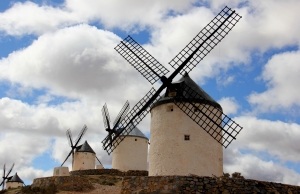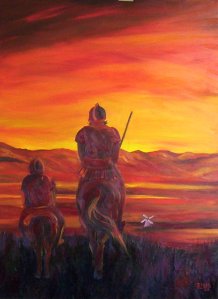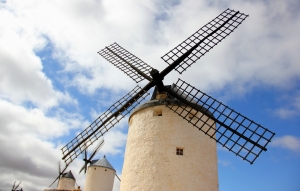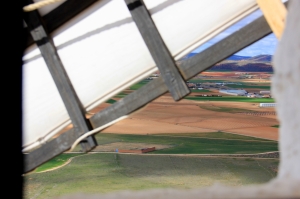
At this point they came in sight of thirty forty windmills that there are on plain, and as soon as Don Quixote saw them he said to his squire, “Fortune is arranging matters for us better than we could have shaped our desires ourselves, for look there, friend Sancho Panza, where thirty or more monstrous giants present themselves, all of whom I mean to engage in battle and slay, and with whose spoils we shall begin to make our fortunes; for this is righteous warfare, and it is God’s good service to sweep so evil a breed from off the face of the earth.”
“What giants?” said Sancho Panza.
“Those thou seest there,” answered his master, “with the long arms, and some have them nearly two leagues long.”
“Look, your worship,” said Sancho; “what we see there are not giants but windmills, and what seem to be their arms are the sails that turned by the wind make the millstone go.”
~ Don Quixote (Part I, ch 8), Cervantes

Published in two volumes in 1605 and 1615, The Ingenious Gentleman Don Quixote of La Mancha by Miguel de Cervantes, is considered the most influential work of Spanish literature. It appears on almost every list of greatest fiction works ever compiled; some even put it at the top.

Cervantes himself is not only known as the greatest writer in the Spanish language, but also as the world’s first novelist. His major work, Don Quixote (quoted above), is a satire of the romanticism in the age of chivalry, and Cervantes’ choice to create a madman hero enabled him to showcase various elements of human behavior such as deviance, aberrance, and other eccentricities.
The Man of La Mancha (an arid but fertile plateau region south of Madrid) is paired with his character foil: the bumbling and simplistic, Sancho Panza. The two of them travel across the area battling imaginary foes and winning the hearts of imaginary princesses as the hero sets out to revive chivalry and bring justice to the land.

The now widely used English idiom “Tilting at Windmills” refers to Don Quixote’s ill-advised bout against a group of what he perceives to be giants. The idiom implies a vain effort that cannot be won against a real or imagined opponent that is impossible to best.
Living in Spain awarded us an opportunity to witness these “giants” of La Mancha first hand just outside the town of Consuegra. Nine windmills remain there, perched in an uneven row along a rocky cliff. They are accompanied by a small castle, where visitors can tour. These windmills may have been the set that inspired Cervantes to write his famous scene, but there are also other windmills in the region – in fact, we passed quite a few on the way to Consuegra.

As I move from country to country and job to job, I find myself struggling against tilting at my own windmills, as I’m sure all of you do at times. Let’s just hope that we don’t find ourselves losing uphill battles more often than we win them.
Hasta La Proxima…
-Justin
Great story and photos. Makes me feel like I was there Seriously, good travelog. Wish you’d put more photos with you in them though.
Great blog! Good imagery.